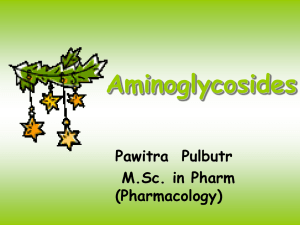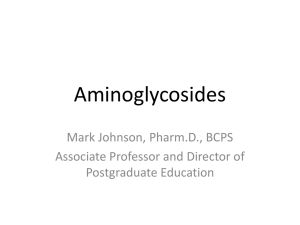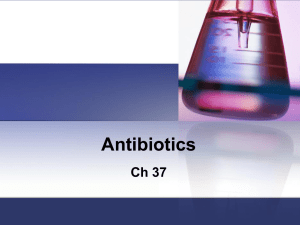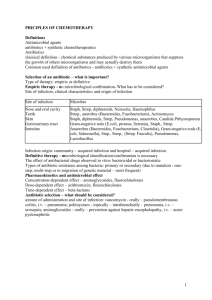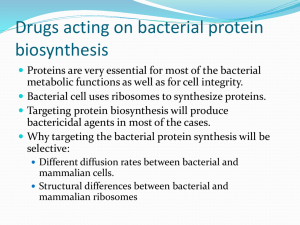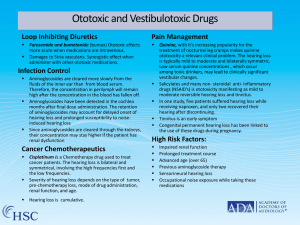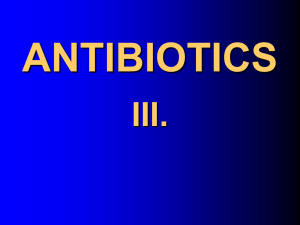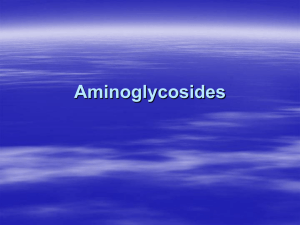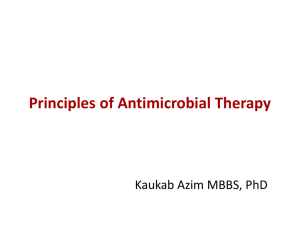Aminoglycoside
advertisement
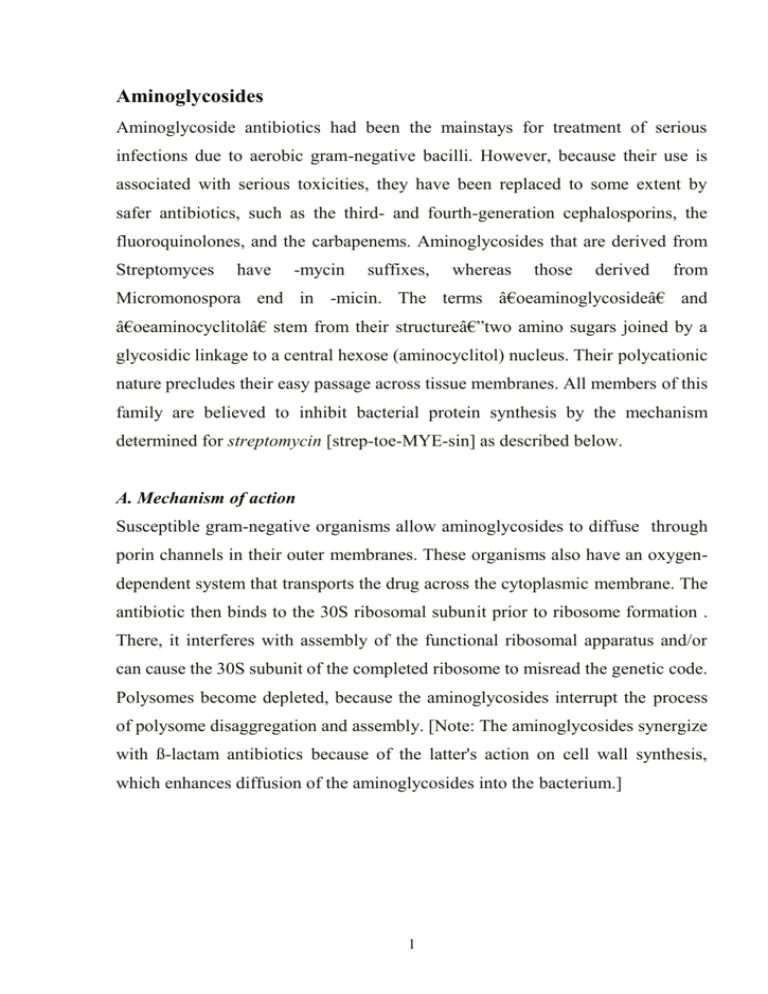
Aminoglycosides Aminoglycoside antibiotics had been the mainstays for treatment of serious infections due to aerobic gram-negative bacilli. However, because their use is associated with serious toxicities, they have been replaced to some extent by safer antibiotics, such as the third- and fourth-generation cephalosporins, the fluoroquinolones, and the carbapenems. Aminoglycosides that are derived from Streptomyces have -mycin suffixes, whereas those derived from Micromonospora end in -micin. The terms â€oeaminoglycoside†and â€oeaminocyclitol†stem from their structure—two amino sugars joined by a glycosidic linkage to a central hexose (aminocyclitol) nucleus. Their polycationic nature precludes their easy passage across tissue membranes. All members of this family are believed to inhibit bacterial protein synthesis by the mechanism determined for streptomycin [strep-toe-MYE-sin] as described below. A. Mechanism of action Susceptible gram-negative organisms allow aminoglycosides to diffuse through porin channels in their outer membranes. These organisms also have an oxygendependent system that transports the drug across the cytoplasmic membrane. The antibiotic then binds to the 30S ribosomal subunit prior to ribosome formation . There, it interferes with assembly of the functional ribosomal apparatus and/or can cause the 30S subunit of the completed ribosome to misread the genetic code. Polysomes become depleted, because the aminoglycosides interrupt the process of polysome disaggregation and assembly. [Note: The aminoglycosides synergize with ß-lactam antibiotics because of the latter's action on cell wall synthesis, which enhances diffusion of the aminoglycosides into the bacterium.] 1 B. Antibacterial spectrum The aminoglycosides are effective in the empirical treatment of infections suspected of being due to aerobic gram-negative bacilli, including Pseudomonas aeruginosa. To achieve an additive or synergistic effect, aminoglycosides are often combined with a ß-lactam antibiotic, or vancomycin, or a drug active against anaerobic bacteria. All aminoglycosides are bactericidal. The exact mechanism of their lethality is unknown because other antibiotics that affect protein synthesis are generally bacteriostatic. [Note: The aminoglycosides are effective only against aerobic organisms because strict anaerobes lack the oxygen-requiring drug transport system.] Some therapeutic applications of four commonly used aminoglycosides—amikacin [am-i KAY-sin], gentamicin [jenta-MYE-sin], tobramycin [toe-bra-MYE-sin], and streptomycinâ C. Resistance Resistance can be caused by 1) decreased uptake of drug when the oxygendependent transport system for aminoglycosides or porin channels are absent and 2) plasmid-associated synthesis of enzymes (for example, acetyl transferases, nucleotidyltransferases, and phosphotransferases) that modify and inactivate aminoglycoside antibiotics. Each of these enzymes has its own aminoglycoside specificity; therefore, cross-resistance is not an invariable rule. [Note: Amikacin is less vulnerable to these enzymes than are the other antibiotics of this group.] D. Pharmacokinetics Administration: The highly polar, polycationic structure of the aminoglycosides prevents adequate absorption after oral administration . Therefore, all aminoglycosides (except neomycin [nee-oh-MYE-sin]) must be given parenterally to achieve adequate serum levels. [Note: The severe nephrotoxicity associated with neomycin precludes parenteral administration, and its current use is limited to topical application for skin infections or oral administration to 2 prepare the bowel prior to surgery.] The bactericidal effect of aminoglycosides is concentration and time dependent; that is, the greater the concentration of drug, the greater the rate at which the organisms die. They also have a postantibiotic effect. Because of these properties, once-daily dosing with the aminoglycosides can be employed. This results in fewer toxicities and is less expensive to administer. The exceptions are pregnancy, neonatal infections, and bacterial endocarditis, in which these agents are administered in divided doses every 8 hours. [Note: The dose that is administered is calculated based on lean body mass, because these drugs do not distribute into fat.] 1. Distribution: All the aminoglycosides have similar pharmacokinetic properties. Levels achieved in most tissues are low, and penetration into most body fluids is variable. Concentrations in CSF are inadequate, even when the meninges are inflamed. Except for neomycin, the aminoglycosides may be administered intrathecally or intraventricularly. High concentrations accumulate in the renal cortex and in the endolymph and perilymph of the inner ear, which may account for their nephrotoxic and ototoxic potential. All aminoglycosides cross the placental barrier and may accumulate in fetal plasma and amniotic fluid. 2.Fate: Metabolism of the aminoglycosides does not occur in the host. All are rapidly excreted into the urine, predominantly by glomerular filtration . Accumulation occurs in patients with renal failure and requires dose modification. E. Adverse effects It is important to monitor plasma levels of gentamicin, tobramycin, and amikacin to avoid concentrations that cause dose-related toxicities [Note: When the drugs are administered two to three times daily, both peak and trough levels are measured. Peak levels are defined as those obtained 30 minutes to 1 hour after 3 infusion. Trough levels are obtained immediately before the next dose. When once-daily dosing is employed, only the trough concentrations are monitored.] Patient factors, such as old age, previous exposure to aminoglycosides, and liver disease, tend to predispose patients to adverse reactions. The elderly are particularly susceptible to nephrotoxicity and ototoxicity. Ototoxicity: Ototoxicity (vestibular and cochlear) is directly related to high peak plasma levels and the duration of treatment. The antibiotic accumulates in the endolymph and perilymph of the inner ear, and toxicity correlates with the number of destroyed hair cells in the organ of Corti. Deafness may be irreversible and has been known to affect fetuses in utero. Patients simultaneously receiving another ototoxic drug, such as cisplatin or the loop diuretics, furosemide, bumetanide, or ethacrynic acid, are particularly at risk. Vertigo and loss of balance (especially in patients receiving streptomycin) may also occur, because these drugs affect the vestibular apparatus. Nephrotoxicity: Retention of the aminoglycosides by the proximal tubular cells disrupts calcium-mediated transport processes, and this results in kidney damage ranging from mild, reversible renal impairment to severe, acute tubular necrosis, which can be irreversible. Neuromuscular paralysis: This side effect most often occurs after direct intraperitoneal or intrapleural application of large doses of aminoglycosides. The mechanism responsible is a decrease in both the release of acetylcholine from prejunctional nerve endings and the sensitivity of the postsynaptic site. Patients with myasthenia gravis are particularly at risk. Prompt administration of calcium gluconate or neostigmine can reverse the block. Allergic reactions: Contact dermatitis is a common reaction to topically 4. applied neomycin. 4
